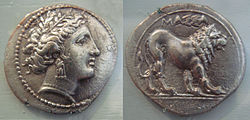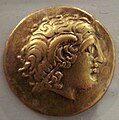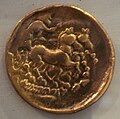Greeks in pre-Roman Gaul

Location of the Greek colony of Marseille.
Part of a series on the | ||||||||||||||||||
|---|---|---|---|---|---|---|---|---|---|---|---|---|---|---|---|---|---|---|
| History of France | ||||||||||||||||||
   | ||||||||||||||||||
Prehistory
| ||||||||||||||||||
Ancient
| ||||||||||||||||||
Early Middle Ages
| ||||||||||||||||||
Middle Ages
| ||||||||||||||||||
Early modern
| ||||||||||||||||||
Long 19th century
| ||||||||||||||||||
20th century
| ||||||||||||||||||
Timeline | ||||||||||||||||||
The Greeks in pre-Roman Gaul have a significant history of settlement, trade, cultural influence, and armed conflict in the Celtic territory of Gaul (modern France), starting from the 6th century BC during the Greek Archaic period. Following the founding of the major trading post of Massalia in 600 BC by the Phocaeans at present day Marseille, Massalians had a complex history of interaction with peoples of the region.
Contents
1 Settlement at Marseille (600 BC)
2 Greek trade in Gaul
3 Legacy
3.1 Numismatics
3.1.1 Coins from the 5th to 1st century BC
4 See also
5 Notes
6 References
Settlement at Marseille (600 BC)

Remains of the Greek harbour in the Jardin des Vestiges in central Marseille, the most extensive Greek settlement in pre-Roman Gaul
The oldest city within modern France, Marseille, was founded around 600 BC by Greeks from the Asia Minor city of Phocaea (as mentioned by Thucydides Bk1,13, Strabo, Athenaeus and Justin) as a trading post or emporion (Greek: ἐμπόριον) under the name Μασσαλία (Massalia).[1][2]
A foundation myth reported by Aristotle in the 4th century BC as well as by Latin authors, recounts how the Phocaean Protis (son of Euxenus) married Gyptis (or Petta), the daughter of a local Segobriges king called Nannus, thus giving him the right to receive a piece of land where he was able to found a city.[2][3][4] The contours of the Greek city have been partially excavated in several neighborhoods.[5][6] The Phocaean Greeks introduced the cult of Artemis, as in their other colonies.[7]
It is thought that contacts started even earlier however, as Ionian Greeks traded in the Western Mediterranean and Spain, but only very little remains from that earlier period.[1] Contacts developed undisputedly from 600 BC, between the Celts and Celto-Ligurans and the Greeks in the city of Marseille and their other colonies such as Agde, Nice, Antibes, Monaco, Emporiae and Rhoda.[1][8] The Greeks from Phocaea also founded settlements in the island of Corsica, such as at Alalia.[9] From Massalia, the Phocaean Greeks also founded cities in northeastern Spain such as Emporiae and Rhoda.

In legend, Gyptis, daughter of the king of the Segobriges, chose the Greek Protis, who then received a site for founding Massalia.
Before the Greeks came to pre-eminence in the Gulf of Lion, trade was mainly handled by Etruscans and Carthaginians.[9] The Greeks of Massalia had recurrent conflicts with Gauls and Ligurians of the region,[10] and engaged in naval battles against Carthaginians in the late 6th century (Thucydides 1.13) and probably in 490 BC, and soon entered into a treaty with Rome.[7]
According to Charles Ebel, writing in the 1960s, "Massalia was not an isolated Greek city, but had developed an Empire of its own along the coast of southern Gaul by the fourth century".[11] But the idea of a Massalian "empire" is no longer credible in the light of recent archaeological evidence, which shows that Massalia never even had a very large chora (agricultural territory under its direct control).[12] However further archaeological evidence since shows Massalia had over twelve cities in its network in France, Spain, Monaco and Corsica. Cities Massalia founded that still exist today are Nice, Antibes, Monaco, Le Brusc, Agde, and Aleria. There is evidence of direct rule of at least two of their cities with a flexible system of autonomy as suggested by Emporion and Rhodus' own coin minting. Massalia's empire was not the same as the monolithic of the ancient world or of the nineteenth century being a scattered group of cities connected by the sea and rivers. The Delian League was also a scattered group of cities spread far across the sea and became known as the Athenian Empire.[13]
Greek Marseille eventually became a centre of culture which drew some Roman parents to send their children there to be educated. According to earlier views, a purported hellenization of Southern France prior to the Roman Conquest of Transalpine Gaul is thought to have been largely due to the influence of Massalia.[14][15] However, more recent scholarship has shown that the idea of Hellenization was illusory (and that the concept itself is seriously flawed). The power and cultural influence of Massalia have been called into question by demonstrating the limited territorial control of the city and showing the distinctive cultures of indigenous societies. Local Gauls were not Grecophiles who wanted to imitate Greek culture, but peoples who selectively consumed a very limited range of Greek objects (mostly ceramic vessels for drink) that they incorporated into their own cultural practices according to their own systems of value.[16][17]
Greek trade in Gaul

The Vix krater, an imported Greek wine-mixing vessel from 500 BC attests to the trade exchanges of the period
These eastern Greeks, established on the shores of southern France, were in close relations with the Celtic inhabitants of the region, and during the late 6th and 5th centuries BC Greek artifacts penetrated northwards alongs the Rhône and Saône valleys as well as the Isère.[1][2] Massalian grey monochrome pottery has been discovered in the Hautes Alpes and as far north as Lons-le-Saunier, as well as three-winged bronze arrowheads as far as northern France, and amphorae from Marseille and Attic pottery at Mont Lassois.[1][18] The site of Vix in northern Burgundy is a well-known example of a Hallstatt settlement where such Mediterranean objects were consumed, albeit in small quantities. Some, like the famous Vix krater, were spectacular in nature.[19]

Detail from Vix krater: frieze of hoplites and four-horse chariots on the rim
From Marseille, maritime trade also developed with Languedoc and Etruria, and with the Greek city of Emporiae on the coast of Spain.[2] Massalia traded as least as far as Gades and Tartessus on the western coast of the Iberian peninsula, as described in the Massaliote Periplus, although this trade was probably blocked by the Carthaginians at the Pillars of Hercules after 500 BC.[20][21]
The mother city of Phocaea would ultimately be destroyed by the Persians in 545, further reinforcing the exodus of the Phocaeans to their settlements of the Western Mediterranean.[9][22] Trading links were extensive, in iron, spices, wheat and slaves.[23] It has been claimed frequently that a trade in tin, indispensable for the manufacture of bronze, seems to have been established at that time between Cornwall in modern England, through the Channel, and along the Seine valley, Burgundy and the Rhône-Saône valleys to Marseille.[23] However, the evidence for this is weak, at best.[24]
Legacy

Statue of Greek explorer, Pytheas of Massilia, located on the exterior of the Palais de la Bourse. He explored northern Europe from Marseille c. 325 BC
Overland trade with Celtic countries beyond the Mediterranean region declined around 500 BC, in conjunction with the troubles following the end of the Halstatt civilization.[2] The site of Mont Lassois was abandoned around that time.[2]
The Greek colony of Massalia remained active in the following centuries. Around 325 BC, Pytheas (Ancient Greek Πυθέας ὁ Μασσαλιώτης) made a voyage of exploration to northwestern Europe as far as the Arctic Circle from his city of Marseilles.[25][26] His discoveries contributed to the elaboration of the ancient world maps of Dicaearchus, Timaeus and Eratosthenes, and to the development of the parallels of latitude.[26][27]

Tablet with Gallo-Greek inscription found south of Nîmes (Musée Calvet, Avignon)
The La Tène style, based on floral ornamentation, in contrast to the geometric styles of Early Iron Age Europe, can be traced to an imaginative re-interpretation of motifs on imported objects of Greek or Etruscan origin.[28][29]
During his conquest of Gaul, Caesar reported that the Helvetii were in possession of documents in the Greek script, and all Gaulish coins used the Greek script until about 50 BC.[14]
Numismatics
@media all and (max-width:720px).mw-parser-output .tmulti>.thumbinnerwidth:100%!important;max-width:none!important.mw-parser-output .tmulti .tsinglefloat:none!important;max-width:none!important;width:100%!important;text-align:center


Celtic coinage emerged in the 4th century BC, and, influenced by trade with the Greeks and the supply of mercenaries to them, initially copied Greek designs.[14][30] Celtic coinage was influenced by Greek designs,[31] and Greek letters can be found on various Celtic coins, especially those of Southern France.[32] Greek coinage occurred in the three Greek cities of Massalia, Emporiae and Rhoda, and was copied throughout southern Gaul.[30]
Coins in northern Gaul were especially influenced by the coinage of Philip II of Macedon and his famous son Alexander the Great.[30]
Celtic coins often retained Greek subjects, such as the head of Apollo on the obverse and two-horse chariot on the reverse of the gold stater of Philip II, but developed their own style from that basis, thus establishing a Graeco-Celtic synthesis.[14][30]
After this first period in which Celtic coins rather faithfully reproduced Greek types, designs started to become more symbolic, as exemplified by the coinage of the Parisii in the Belgic region of northern France.[30] By the 2nd century BC, the Greek chariot was only represented by a symbolic wheel.[14]
The Armorican Celtic style in northwestern Gaul also developed from Celtic designs from the Rhine valley, themselves derived from earlier Greek prototypes such as the wine scroll and split palmette.[30]
With the Roman invasion of Gaul, Greek-inspired Celtic coinage started to incorporate Roman influence instead, until it disappeared to be completely replaced by Roman coinage.[30]
By the 1st century BC, the coinage of the Greeks of Marseille circulated freely in Gaul,[14] also influencing coinage as far afield as Great Britain. The coins of the Sunbury hoard, thought to have been manufactured in Kent, show designs derived from Greek coins from Marseille with the stylised head of Apollo and a butting bull.[33] Recently original bronze coins 3rd-2nd century BC from Greek Marseille have been found in several locations around Kent, UK.[34]
Coins from the 5th to 1st century BC
Celtic coin designs progressively became more abstract, as is exemplified by the coins of the Parisii:

Massalia

Rhoda

Emporiae

Parisii

Sunbury-on-Thames, Britain, 100–50 BC[35]

Gold coin of the Sequani
(based in present-day Franche-Comté)

Biga and driver on a Sequanian coin

Santones (based in present-day Charente-Maritime)

More abstract chariot and driver on Santonian coin
See also
- Pytheas
- Emporion
Notes
^ abcde The Cambridge ancient history p.754
^ abcdef A history of ancient Greece Claude Orrieux p.62
^ The Celts: a history by Raithi O Hogain, p.27
^ A Companion to the Classical Greek World Konrad H. Kinzl p.183
^ Archaeologies of Colonialism: Consumption, Entanglement, and Violence in Ancient Mediterranean France by Michael Dietler, 2010, p. 308-321 [1]
^ Marc Bouiron and Henri Tréziny (eds.) Marseille: trames et paysages urbains de Gyptis au Roi René, 2001, Edisud.
^ ab Transalpine Gaul: the emergence of a Roman province by Charles Ebel p.10- [2]
^ The western shores of Turkey: discovering the Aegean and Mediterranean coasts by John Freely p.91 [3]
^ abc A history of ancient Greece Claude Orrieux p.61
^ Archaeologies of Colonialism: Consumption, Entanglement, and Violence in Ancient Mediterranean France by Michael Dietler, 2010, p.157-182 [4]
^ Transalpine Gaul: the emergence of a Roman province by Charles Ebel p.2
^ Archaeologies of Colonialism: Consumption, Entanglement, and Violence in Ancient Mediterranean France by Michael Dietler, 2010 [5]
^ The Greek Empire of Marseille: Discoverer of Britain, Saviour of Rome by Christopher Gunstone, 2013, p.37, p.150
^ abcdef The European Iron Age by John Collis p.144 ff
^ King 1990, pp. 11–33, Chapter I, "Greeks and Celts"
^ "World's richest cities in 2009". City Mayors. 22 August 2009. Retrieved 14 June 2010..mw-parser-output cite.citationfont-style:inherit.mw-parser-output qquotes:"""""""'""'".mw-parser-output code.cs1-codecolor:inherit;background:inherit;border:inherit;padding:inherit.mw-parser-output .cs1-lock-free abackground:url("//upload.wikimedia.org/wikipedia/commons/thumb/6/65/Lock-green.svg/9px-Lock-green.svg.png")no-repeat;background-position:right .1em center.mw-parser-output .cs1-lock-limited a,.mw-parser-output .cs1-lock-registration abackground:url("//upload.wikimedia.org/wikipedia/commons/thumb/d/d6/Lock-gray-alt-2.svg/9px-Lock-gray-alt-2.svg.png")no-repeat;background-position:right .1em center.mw-parser-output .cs1-lock-subscription abackground:url("//upload.wikimedia.org/wikipedia/commons/thumb/a/aa/Lock-red-alt-2.svg/9px-Lock-red-alt-2.svg.png")no-repeat;background-position:right .1em center.mw-parser-output .cs1-subscription,.mw-parser-output .cs1-registrationcolor:#555.mw-parser-output .cs1-subscription span,.mw-parser-output .cs1-registration spanborder-bottom:1px dotted;cursor:help.mw-parser-output .cs1-hidden-errordisplay:none;font-size:100%.mw-parser-output .cs1-visible-errorfont-size:100%.mw-parser-output .cs1-subscription,.mw-parser-output .cs1-registration,.mw-parser-output .cs1-formatfont-size:95%.mw-parser-output .cs1-kern-left,.mw-parser-output .cs1-kern-wl-leftpadding-left:0.2em.mw-parser-output .cs1-kern-right,.mw-parser-output .cs1-kern-wl-rightpadding-right:0.2em
^ "The Iron Age in Mediterranean France: colonial encounters, entanglements, and transformations" by Michael Dietler, Journal of World Prehistory 1997, vol.11, pages 269-357
^ Consumption and Colonial Encounters in the Rhône Basin of France: A Study of Early Iron Age Political Economy by Michael Dietler, Monographies d’Archéologie Meditérranéenne, 21, CNRS, 2005, p.39-102
^ L'oppidum de Vix et la civilisation hallstattienne finale dans l'Est de la France by René Joffroy. Paris, Les Belles Lettres, 1960
^ Ireland and the classical world by Philip Freeman p.32
^ The History of Cartography John Brian Harley p.150
^ The ancient mariners Lionel Casson p.74
^ ab A history of ancient Greece Claude Orrieux p.63
^ Consumption and Colonial Encounters in the Rhône Basin of France: A Study of Early Iron Age Political Economy by Michael Dietler, Monographies d’Archéologie Meditérranéenne, 21. CNRS, 2005.[6]
^ The History of Cartography by John Brian Harley p.150
^ ab The hellenistic world by Frank William Walbank p.205
^ The History of Cartography John Brian Harley p.150-
^ European prehistory: a survey Sarunas Milisauskas p.354
^ The archaeology of late Celtic Britain and Ireland, c. 400–1200 AD Lloyd Robert Laing p.342
^ abcdefg Celtic culture: a historical encyclopedia" John T. Koch p.461-
^ Boardman, John (1993), The Diffusion of Classical Art in Antiquity, Princeton University Press, p.308.
^ Celtic Inscriptions on Gaulish and British Coins" by Beale Poste p.135 [7]
^ Museum of London exhibit
^ The Greek Empire of Marseille: Discoverer of Britain, Saviour of Rome, (2013) p. 176, p. 548
^ Showing stylised head of Apollo and butting bull
References
Boardman, John (1993), The Diffusion of Classical Art in Antiquity, Princeton University Press, ISBN 0-691-03680-2
Dietler, Michael (2005), Consumption and Colonial Encounters in the Rhône Basin of France: A Study of Early Iron Age Political Economy, Monographies d’Archéologie Meditérranéenne, 21. CNRS, ISBN 2-912369-10-X
Dietler, Michael (2010), Archaeologies of Colonialism: Consumption, Entanglement, and Violence in Ancient Mediterranean France, University of California Press, ISBN 0-520-26551-3
Ebel, Charles (1966), Pre-Roman Greeks in Gaul, University of Iowa
Gunstone, Christopher (2013), The Greek Empire of Marseille: Discoverer of Britain, Saviour of Rome, CreateSpace, ISBN 978-1481239660
King, Anthony (1990), Roman Gaul and Germany, University of California Press, ISBN 0-520-06989-7








